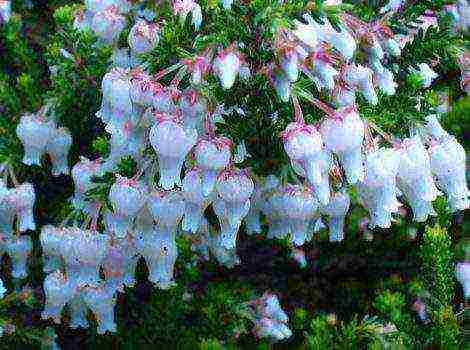Content
 Clarity is grown in the open field. Planting this perennial flower will allow you to quickly plant large areas, but without proper care, the cleaver can degenerate into a weed. Photos of various types of lamb will help you choose the right variety for each section of the garden.
Clarity is grown in the open field. Planting this perennial flower will allow you to quickly plant large areas, but without proper care, the cleaver can degenerate into a weed. Photos of various types of lamb will help you choose the right variety for each section of the garden.
Peculiarities of the yarn
The lamb is widespread in the wild. You can meet its species in deciduous and coniferous forests, in the mountains, on the slopes of river banks, along the roadsides. Outwardly, lamb is similar to nettle, but does not burn and has a more interesting leaf color.
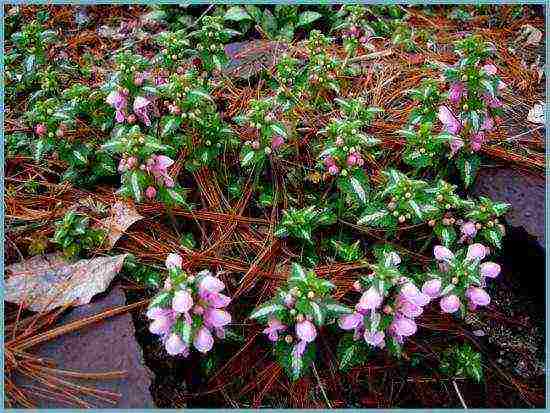
Lamb is a very weather resistant plant
Lamb is a perennial ground cover plant. Creeping stems, take root at the nodes, capturing more and more new areas. The main value of the lamb as an ornamental plant is leaves with a silvery tint or a marble pattern on top. The leaves are ovoid with teeth and sit on petioles. Peduncles are erect, up to 30 cm long. Flowering occurs in spring - early summer. Flowers of yellow, lilac or purple spongy shape.
The lamb tolerates frost very well and does not require shelter. In winter it leaves with green leaves, and in early spring, one of the first in the garden to sprout new shoots.
Clarity varieties
About 80 species of this perennial plant are found in nature, but only a few of them are used in horticulture:
- yellow cleaver - perennial plant, marbled foliage. The flowers are formed in the axils of the leaves, are two-lipped and have a yellow color;

Yellow lamb
- Orval's cleaver - has bright green leaves and purple flowers. This type of lamb has a compact size, is less active during growth;
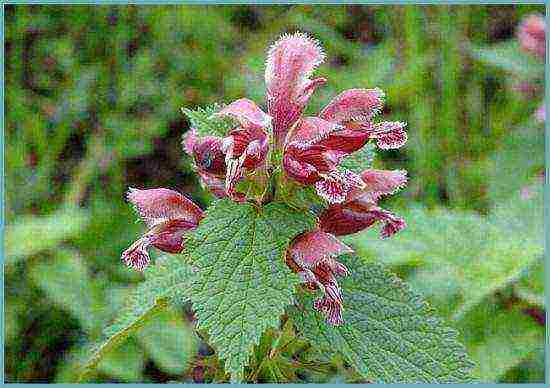
Orval's lamb
- speckled (spotted) - a rapidly growing species, green foliage with a silvery "dusting". Depending on the variety, the flowers are painted in colors from white to poisonous purple.
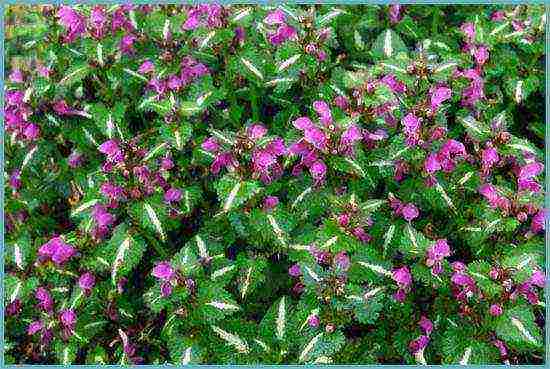
Speckled lamb
Breeders have bred many varieties of yasnotka, each of which has its own unique characteristics. The most popular varieties: Florentium, Type Ronsdorf, Album, Roseum, WhiteNancy, Pink Pewter, Beacon Silver, Checkere. Photos of representatives of varieties will help you make the right choice.
Reproduction and planting of a lamb
A semi-shady cool place on the east or west side of the site is suitable for planting a lamb. It is not worth planting a plant under the trees, since the leaves will be wet for a long time after the rain, but under the bushes the cleaver feels great. The plant does not have any special requirements for the soil.

The plant grows rather quickly and takes up space.
Cleaver reproduces in three ways:
- By dividing the bush.
- By cuttings.
- Seeds.
Dividing a bush is the simplest and most effective method of breeding a bush. The split-off part of the bush quickly takes root in a new place in spring. Superficially located roots grow rapidly, forming new shoots. Flowering occurs in the first year of transplantation.
By cuttings, the spotted beetle reproduces.Cut young shoots are planted directly into the ground. Cuttings are carried out during the entire growing season.

Types of lamb
Lamb seeds are sown on moist soil superficially, slightly pressing down. Due to the cold hardiness of the lamb, no greenhouse conditions are needed for seed germination. Seeds are also capable of self-sowing, so excess seedlings around adult bushes must be removed. Growing lamb seedlings at home is possible, but not justified. The first shoots appear in 1.5 months.
Advice. Seeds of yellow ashberry are sown in autumn. It is preferable to sow seeds of other plant species in early spring, as soon as there is an opportunity to enter the site.
Care: watering, fertilizing, pest control
Despite its unpretentiousness, the lamb requires some care.
Watering. Lamb loves moist soil, but does not tolerate stagnant water. The plant can withstand a short drought. In this case, the appearance of the plant may suffer, but after watering the flower will quickly recover.

Water the claw regularly
Top dressing. At the beginning of growth, the lamb is very responsive to feeding in liquid form. For these purposes, an infused mullein or a ready-made mineral fertilizer is suitable. You cannot overdo it with fertilizers.
Attention! Too much fertilized soil makes the growth aggressive. The plant grows extremely quickly and is even capable of destroying garden flowers growing in its path. The size of the bush must be constantly adjusted by removing excess shoots.
The peculiarity of the lamb is the suppression of weeds in the growth zone of perennials. Weeding is required only around the bush. If you do not pay enough attention to the bush, the bush itself can degenerate into a weed. To avoid this, the bush is cut off after flowering, and throughout the summer it is cultivated by trimming excess shoots.

Do not forget to cut the scrub bushes
With long-term preservation of moisture on the sheets, the lamb can be affected by fungal diseases. And too dry weather contributes to attacks on the whitefly bush, scale insects and spider mites. At the first signs of trouble, the flower must be immediately treated with special means.
The use of clearness in landscape design
In landscape design, the ground cover feature of the lamb is used. She is used to decorate the borders, used to decorate the ground part of the bushes. Lamb is suitable for landscaping unsightly corners and areas shaded by fences and buildings. Clarity's ability to grow among stones is used in the design of alpine slides. In flowerpots, she effectively lowers her stems down.
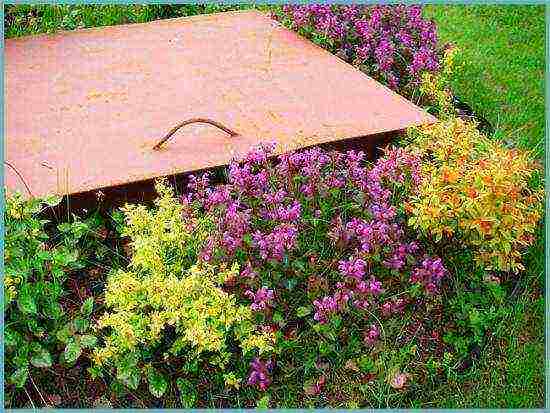
Lamb will decorate both a flower bed and technical buildings
Low-growing bulbs feel great as neighbors of the lamina: daffodils, dwarf tulips, hyacinths. Of the taller partners, hosts, ferns, and lungwort are grown in a flowerbed with a lamb. Various flower arrangements with the use of lamina in the open field are presented in the photo and delight flower growers.
Here she is, unpretentious and pleasing to the eye, lucid. Not requiring labor-consuming care, this flower will decorate your garden and help you create original garden compositions.
Groundcover cleaver: video
Types of lamb: photo

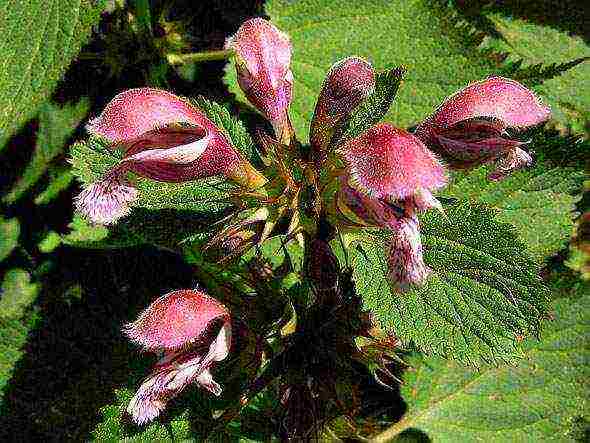
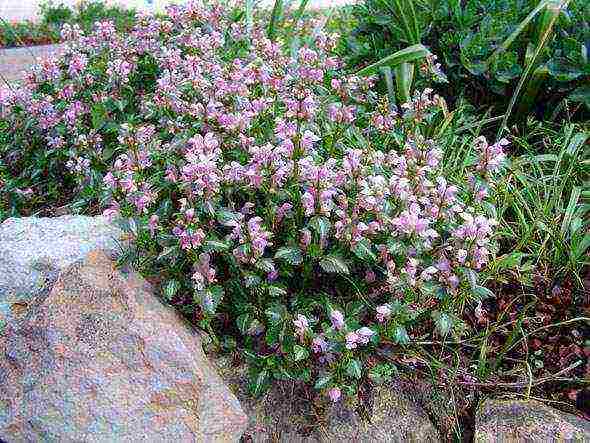
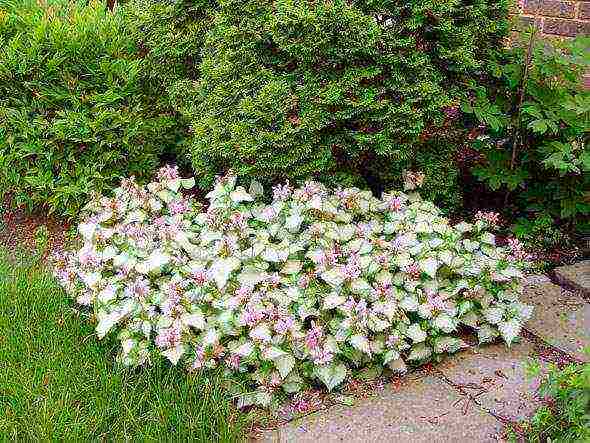
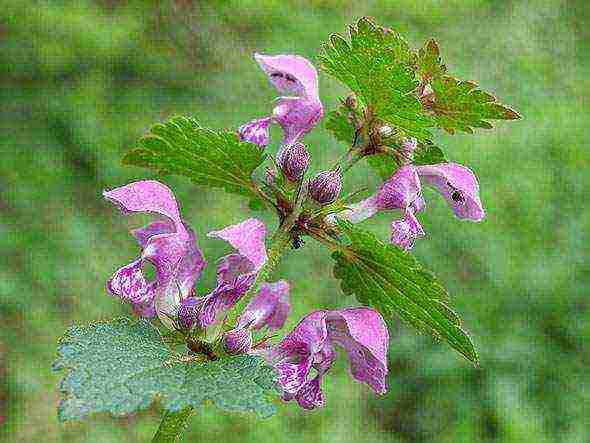
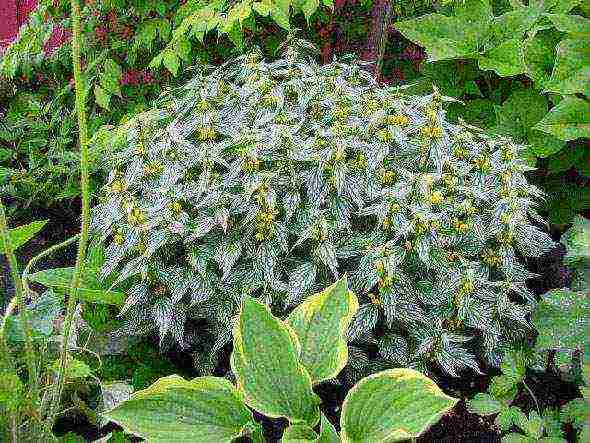
Lamb Is a herb that belongs to the Yasnotkov family. The main places of natural localization are considered to be European countries, the central region of Asia and northern Africa.

Description and features of the yarn
Lamb, plant, which has a branching stem. Depending on the variety, grasses it happens:
-
one-year;
-
two-year;
-
long-term.
The leaves of the plant can be oval or in the form of teeth, in the center there is a small dot resembling silver in color. Flowers most often they are light pink, white and purple in color. Today, they are especially appreciated medicinal properties of the cleaver, among which it is definitely worth highlighting the following:
-
diuretic (causes a profuse flow of urine);
-
coughing up;
-
slowing down bleeding;
-
antiallergenic;
-
is a good means for cleansing the blood from various toxins;
In addition, thanks to the special the properties of the lamb it is widely used in the treatment of colds and various kinds of inflammatory processes. Often used for problems with the respiratory system, liver and kidneys.
Applying a clear note it is produced in the form of infusions and decoctions; in the case of external use, preference is given to compresses and lotions.

Planting and breeding of a lamb
Excellent conditions for planting of a lamb is sandy loam soil and loam. But the grass is able to grow on other types of soil, the main thing is a satisfactory amount of moisture and high-quality drainage of the earth. Preference should be given to soil with weak or neutral acidity.
On such fertile soil as black soil, the grass is capable of overgrowing. It is recommended to plant the plant in partial shade, but in no case under trees, because if it rains, the leaves of the grass will remain wet for a long time, which negatively affects its growth. But in the shade of various bushes, the grass feels just wonderful. Grass propagation is done in the following ways:
-
The bush is divided.
-
Cuttings are used.
-
Seeds are used.
The easiest way to increase the number of this plant is considered to be the division of the bush. In the spring season, the split-off part from the bush takes root in the shortest possible time.
Those roots that are placed on the surface very quickly cover the nearby ground, which causes the emergence of shoots. The plant blooms in the same year as it was planted.
Thanks to cuttings, a much smaller number of varieties of this herb reproduce, but still such are present, and a wonderful example is lamb spotted. In this case, only cut shoots are immediately planted in open soil. Such reproduction is allowed to be carried out throughout the entire growing season of the grass.
Increasing the amount of grass from seeds is the most troublesome option. Grass seeds must be sown in open ground, which must first be slightly moistened.
In the process of spreading the seeds into the soil, they need to be lightly pressed down. It is worth noting that the seeds have the ability to self-sow, because of this, the sprouts that have appeared near the main bush should be removed without fail.
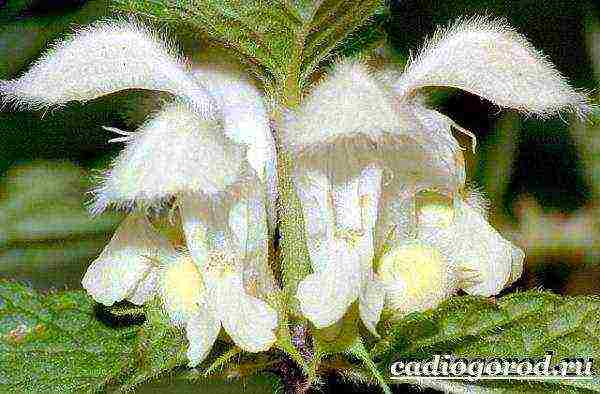
With this method of grass propagation, the first shoots of the lamb can be observed after 45-60 days. Due to the fact that the grass perfectly tolerates the cold, there is no need to create special greenhouses for its growth.
Caring for the clear
Caring for the clear should start from the moment of her disembarkation. It lies in the fact that when placing a plant in open ground, you need to choose a place that will be placed in partial shade. If you place the grass in the open sun, then even constant moisture will not save its leaves, burns are guaranteed to remain on them.
This herb is very fond of water, but there should be a measure everywhere. If you moisten the soil of a plant several times a day, then its root will simply rot. The grass easily tolerates a short-term lack of watering. Certain varieties of plants do not cope well with the cold, for example, the orval, so they need to be mulched.
To feed the grass, you should give preference to natural fertilizers - humus or compost. In the spring season, you can use liquid top dressing or special granules. You can stop here, since a large amount of fertilizer can cause the plant to grow rapidly.
Depending on the variety, the plant blooms between May and June. But if certain varieties (yellow bean), remove the peduncles immediately after their flowering, then the plant is able to bloom again.
Due to the excessive growth rates of this herb, it can cause significant harm to the development of other garden plants, or, in general, go into the category of weeds.
To prevent this from happening, the plant needs to be regularly pruned, and the removal of shoots is mandatory. It is worth noting that such actions have a beneficial effect on the flowering of the plant, it can last until the end of the season. If the grass is of an annual type, then it is recommended to transplant it no earlier than once every five years.
Types and varieties of yasnotka
At this stage of time, 40 species of this plant are distinguished, while the most famous of them are the following:
-
White lily... This plant variety is often called "deaf nettle", but among connoisseurs of traditional medicine this type of plant is called clear medicinal... Treat a perennial type of grass, the rhizome is quite long and creeping. The stem is low, hollow. The shape of the leaves is ovoid-heart-shaped. The flowers are white in color and have a rather pleasant aroma, somewhat reminiscent of honey. The flowers are quite large in size. It has a long flowering period that spans from April to October. This plant variety has fruits - these are egg-shaped nuts with a yellow-gray color. Localization places in nature are the banks of rivers and streams, forests in the territory of the CIS countries.
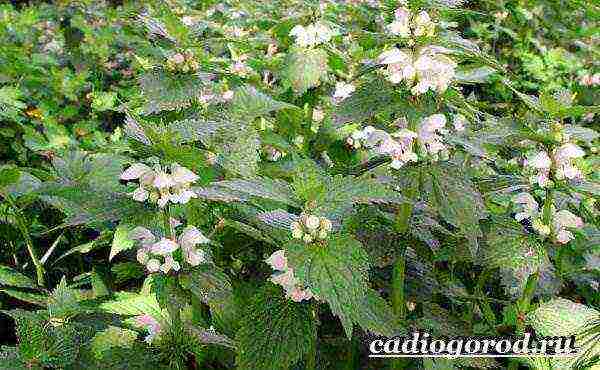
-
Purple lamb. This plant variety belongs to annuals and biennials. It can reach a height of 15 centimeters. The color of the flowers is white and pink. The flowering period covers the time from May to September.
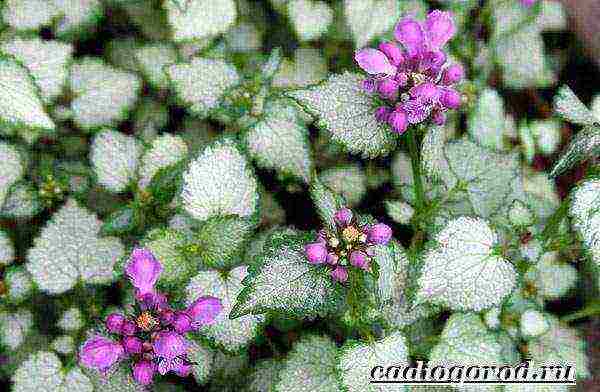
-
Speckled lamb. A plant variety related to perennials. Very often used as a covering grass (to cover the lawn). It has a superficial type of root system. The color of the flowers is pink and purple. The flowering period is rather short and does not exceed a month, usually at the beginning of June. At this stage of time, there are decorative species of speckled lamb, in which there is a much greater variety in the color of flowers.
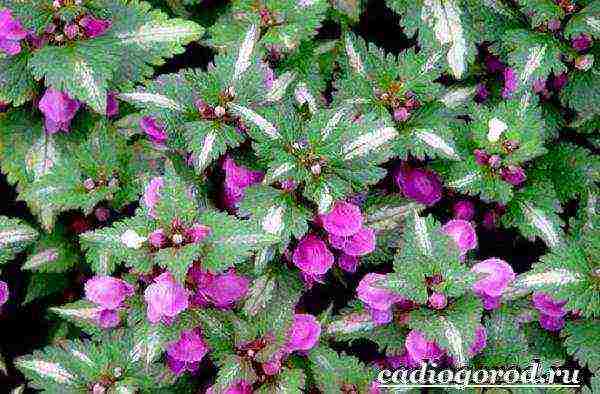
-
Zelenchukovaya lamb... Treat a group of perennial plants. The maximum height is about 30 centimeters. The flowers are yellow in color. The flowering period is short, usually in early May. This variety is distinguished by the fact that in the winter season a special pigment appears on the back of the leaves, which enables the plant to use the heat obtained from the soil. Among the decorative variants of this variety, there are those in which a purple color of flowers is observed.
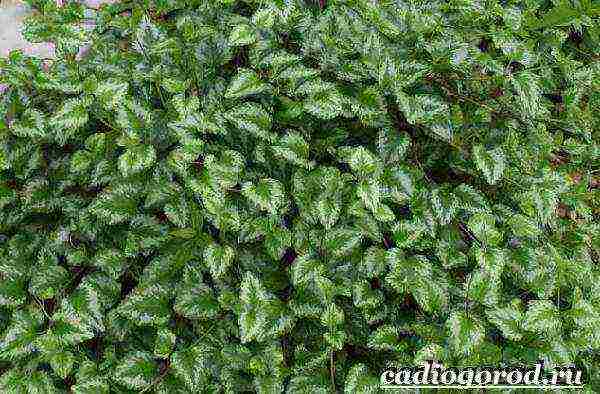
-
Orval's lamb. The plant is of a compact type that can reach a height of 40 centimeters. It tolerates low temperatures perfectly. The flowers are pale pink and purple in color. Flowering is observed for two months - May and June.

-
Herrmanns Proud. Quite an unusual kind of lamb. It grows in the form of a compact bush, the height of which reaches 20 centimeters. The leaves of the plant have a beautiful silvery sheen. This variety cannot be propagated with seeds, because they are simply not available.

-
Type Ronsdorf. A grape variety that has small rounded leaves. Unlike other species of this plant, its growth takes quite a long time.
WITH photo of the yarn can be found below. In addition to the above varieties, there is also a yellow lamb.

Diseases and pests of lamb
Nettle nettle (another name for the plant) is practically not susceptible to any diseases. The only problem that occurs quite often is the development of a fungal infection as a result of over-watering.
It is worth noting that in the event of a prolonged drought, spider mites, whiteflies and scale insects can attack the plant. In the event of pests, the plant should be immediately treated with special preparations.
Lamb is a one- and perennial herb of the Lamb family.In its natural environment, it lives in Eastern Europe, where it most often grows along the banks of rivers and streams, it can be troublesome, like weeds. Found its place among horticultural crops. The green cover persists from spring to frost. Low-growing varieties are grown as ground covers, higher ones - in flower beds.
Botanical description
This fast-growing plant is limited to a height of 15-25 cm. The root system is fibrous, quickly covering a wide area. Shoots branch well. Heart-shaped leaf plates with jagged edges, covered with veins, soft to the touch, attached on long petioles. The width of the leaf is 2-4 cm, the length is 3-8 cm. The main color is dark green, there may be spots of a yellowish or silvery hue.
In internodes, erect peduncles up to 30 cm long appear. They are covered with leaves and flowers. Corollas are two-lipped, 20-25 mm long, painted in a white, pink, purple hue, collected in whorls. In the center of the corolla there are filiform stamens with black-purple anthers. The fruit is coenobium - a box containing 4 triangular nuts. They open up on their own and sow seeds. Flowering lasts from late May to October. The fruits appear in June.
Growing a lamb from seeds

Seeds of a yarn photo
Cleaver is propagated by seeds and vegetatively.
Sowing in the open field
- Sowing seeds is carried out immediately in open ground before winter or early spring.
- Dig up the area, level the soil, distribute the seeds over the surface of the garden. They sprout together.
- When the seeds have sprouted, weed and break through the dense seedlings.
- Usually, spring precipitation is enough for the full development of the cleaver from seeds. But if the weather is dry, hot, be sure to water the garden bed so that the soil does not dry out.
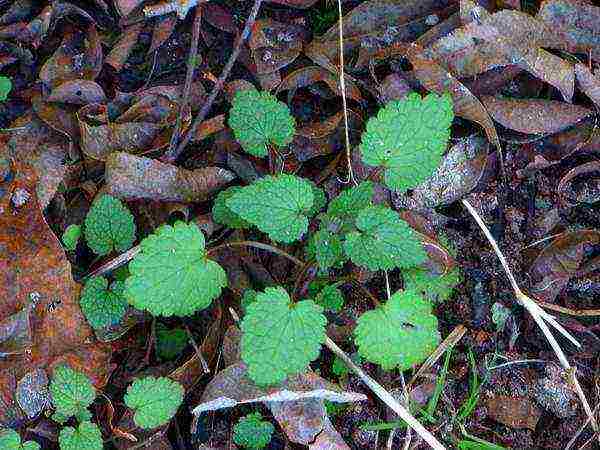
Lamb seed in the open field photo
- If you do not allow the development of weeds, the lamb will cover the space allotted to it with a thick carpet and itself will drown out weeds (except for aggressive perennials).
- Plants grown from seeds will bloom after 2 years of growth.
- It is better not to allow self-seeding so that you do not have to deal with active growth.
- Sow varietal plants far from each other, otherwise varietal differences will disappear after cross-pollination.
Vegetative propagation
Dividing the bush
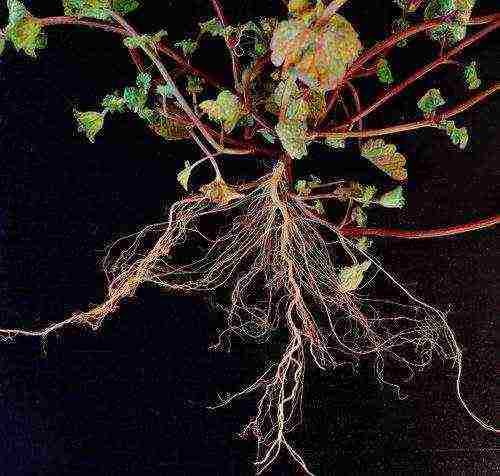
How to divide a bush of a bush photo
Dividing the bush is the most popular breeding method, which allows you to completely preserve varietal characteristics, and flowering begins in the next season. Perform the procedure in the spring. Dig up the overgrown bush, carefully divide it into parts. Plant in holes that are suitable for the size of the root system. Water.
Layers
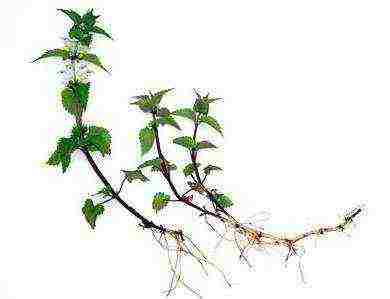
Reproduction of the lamina by layering photo
They are propagated less often by layering. Layers are made in the fall (September-October). Bend the stem to the ground, sprinkle with soil. In the spring, separate the young shoots from the mother plant and plant in a permanent growth site.
Cuttings

Cuttings of a lamb photo
Lamb can be propagated by cuttings. In August, cut the cuttings and root in a sandy peat mixture, covered with a jar or cut plastic bottle. Ventilate and water regularly. Transplant the rooted stalk to a permanent place of growth in September, cover with fallen leaves and spruce branches for the winter.
How to care for a lamb in the garden
Site selection and soil
The plant is unpretentious in care. Grows well in partial shade.
The soil is needed loose, moist, moderately fertile. If the soil is too nutritious, the plant will develop aggressively and the leaves will be mostly green.
Watering and feeding
- Water regularly and abundantly, but do not allow moisture to stagnate.
- In drought, the leaves will dry out, exposing the shoots.
- Feed with compost before flowering.
Pruning and replanting
- Remove wilted inflorescences to enhance decorativeness and avoid unwanted self-seeding.
- To increase bushiness, mow the lane.
- Transplant every 5 years.
The plant is frost-resistant and does not require shelter for the winter.
Diseases and pests
Lamb is disease resistant. Decay of the root system is a consequence of stagnant moisture in the soil. It is important to find a suitable area and regulate watering. Remove affected plants, treat with fungicide.
Spider mites, scale insects, whiteflies, mealybugs are possible plant pests. It is necessary to treat with an insecticide.
Types and varieties of yasnotka with photos and names
The genus has 25 species, but several are decoratively grown with varieties derived from them.
White lamb or stinging nettle Lamium album
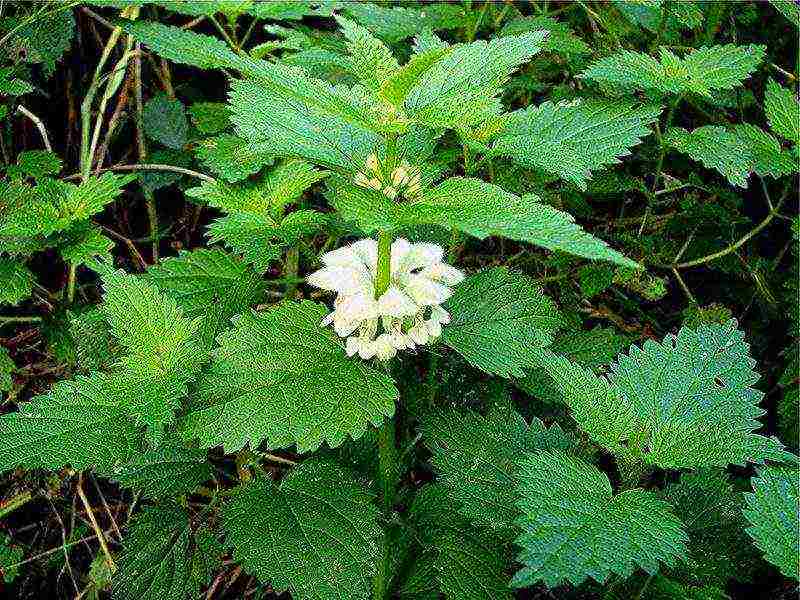
White lamb or stinging nettle Lamium album photo
Perennial, plant height is 15-45 cm. The leaves and the upper part of the stem are covered with long hairs. The leaf plates are oval-heart-shaped with carved edges, arranged alternately on short petioles, painted green. The flowers are white. Flowering occurs in June-September.
Lamb purpurea or red nettle Lamium purpureum

Lamb purpurea or red nettle Lamium purpureum photo
One or biennial plant. The height of the stem is 5-25 cm. It is densely covered with small oval leaves with carved edges, they are colored dark green, pubescent. The inflorescences are pink or white. Blooms from April to September.
Lamb spotted or speckled Lamium maculatum
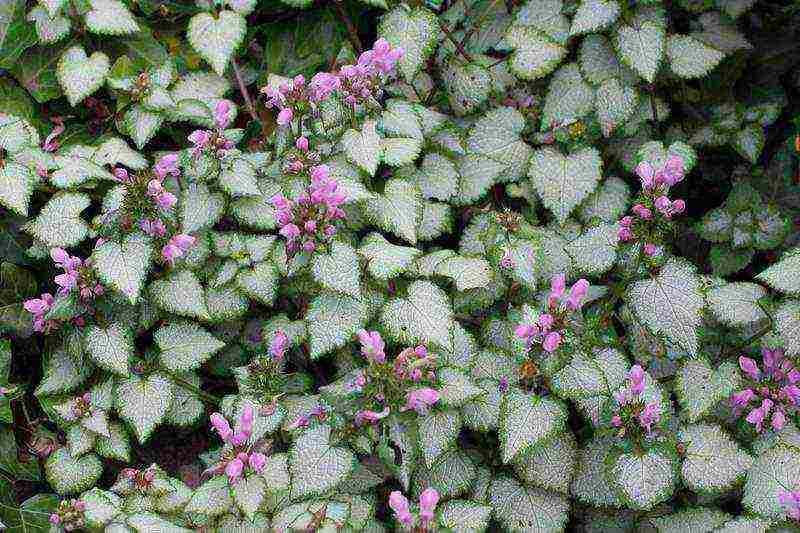
Lamb spotted or speckled Lamium maculatum photo
Perennial herb 30-70 cm high. Branches from the base. The stem is covered with oval leaves, the edges are jagged. The leaf plates are colored green with a silvery central stripe. The flowers are light pink or purple in color. Bloom: May-October.
Varieties:
Album - has snow-white flowers;
Beacon Silver - the plate is silver colored;
Aureum - yellowish leaves, the central vein is highlighted in a lighter tone, the flowers are purple.
Green lamb or yellow Lamium galeobdolon

Green lamb or yellow Lamium galeobdolon photo
Perennial plant with creeping shoots. The stems and leaves are pubescent. The leaf plates are ovoid, the surface is wrinkled, and may have a marble pattern. The flowers are yellow. The upper lip is ovoid, the lower one is three-lobed. Blossom in the period May-October in two stages.
Varieties:
- Argentatum - leaves are wide, colored green with silvery stripes located closer to the edge;
- Silver Carpet - leaves are oblong, have a pattern of silver color.
Orval's lamb Lamium orvala
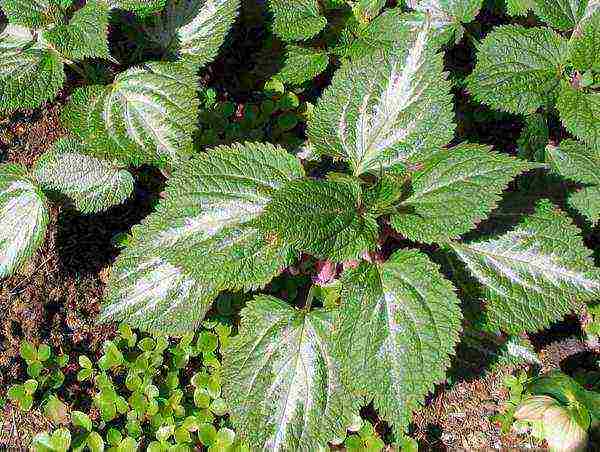
Orval's lamb Lamium orvala cultivar 'Silva' photo
A compact bush about 40 cm high. It blooms from May to June. The flowers are pink, purple.
Application in landscape design
Lamb lamb Lamium amplexicaule photo
The plant is popular in landscape design, especially variegated forms. They are planted in rockeries, mixborders, for landscaping the space between trees and shrubs. Suitable neighbors would be lungwort, hosta, tiarella, heuchera.
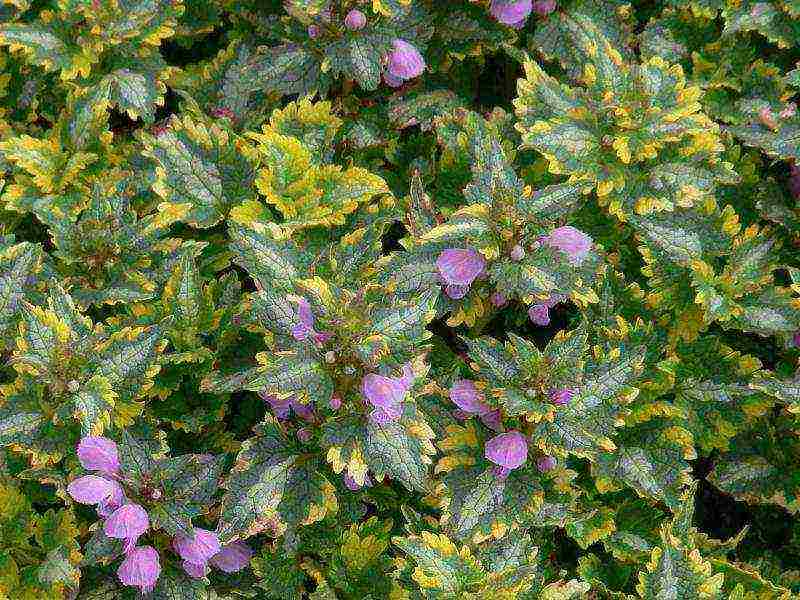
Lamb golden anniversary photo
Lamb is grown as an ampelous plant to decorate gazebos, terraces, balconies.
Healing properties
White lamb in young shoots and flowers contains useful substances (alkaloids, flavonoids, tannins, essential oils, ascorbic acid).
Traditional medicine uses decoctions and infusions. Inside take as an anti-inflammatory, expectorant, diuretic, lotions - for healing wounds and fighting skin diseases. For gynecological diseases, baths are prepared.
There are no clear contraindications for use. Allergic reactions are possible.
Speckled lamb (spotted) native to Asia. Herbaceous plants from the family of lamines have long been considered weeds. They were of interest only because of their medicinal properties. Today, there are about 40 varieties of lamb, but only 2 species are grown in gardens as an ornamental flower.
Speckled lamb (spotted) native to Asia. Herbaceous plants from the family of lamines have long been considered weeds. They were of interest only because of their medicinal properties. Today, there are about 40 varieties of lamb, but only 2 species are grown in gardens as an ornamental flower.
Planting a plant
Lamb has gained popularity among gardeners for its unusual foliage and beautiful flowers. The leaves of the plant, resembling nettle in shape, are covered with light silvery spots. In late spring, fragrant, delicate pink or purple flowers bloom, which persist until almost mid-autumn. Plant height can reach 70 cm.
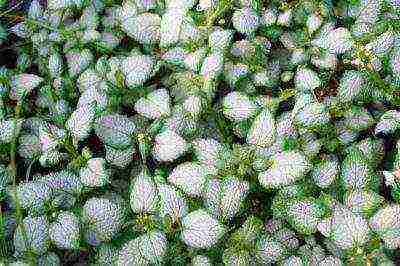
Due to the strong branching, the lamb covers the entire space, turning the flower bed into a variegated carpet. Therefore, you should not plant it on fertile soils, as well as near garden trees and garden crops. Otherwise, the flower will simply clog neighboring plants or transmit fungal diseases to them. But such a ground cover will be an excellent decoration for an alpine slide or rockery. The lighthouse is used to decorate unsightly areas in the garden area, greening curbs and low fences.
Clairvoyant Baba Nina named the signs of the zodiac, on which money will fall from the sky in May 2018 ...
►
The soil is spotted loamy loamy or sandy loam with good drainage and moderate moisture. In the sun, the plant will be uncomfortable, since from the constant drying out of the soil, the grass will simply begin to ache and wither. For planting, it is better to choose shady or semi-shady places with a slight draft.
Low temperatures are not terrible for this plant. Lamb blooms beautifully until late autumn and endures the winter cold. It often retains green leaves even under cover of snow. And the first sprouts can appear already at the beginning of spring, turning into lush grass with the onset of warmth.

You can plant a flower not only in open ground. Lamb grows well in flowerpots and pots. It can be planted in a pot as a home plant. A lamb in a pot looks impressive and can be used for medicinal purposes. Decoctions and tinctures based on its flowers and young shoots are used as a diuretic and anti-inflammatory agent. Lotions relieve skin infections and help wounds heal.
Care rules
Lamb loves moisture, but you should not fill it in so that the roots do not rot. It can withstand a short dry period, after which it quickly recovers. With insufficient watering, the decorativeness of the grass decreases. Especially good watering is important for a plant planted in a sunny place.
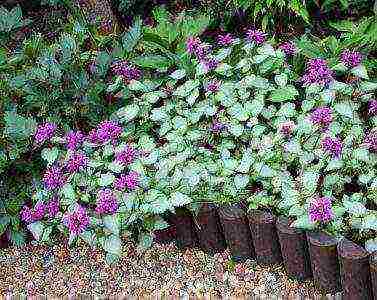
Without proper care, ornamental grass quickly turns into a weed.
The plant needs regular pruning. After flowering, the stems and excess lateral shoots are removed. Pruning and rejuvenating the plant and giving it a decorative shape. In addition, the removal of the peduncle promotes the secondary flowering of the plant at the end of summer.
After pruning, the cleaver can be fed with fertilizers. Top dressing is applied in liquid form. Use any organic fertilizers or mineral preparations. However, you should not get carried away. If the grass is fertilized abundantly, then it will quickly grow and turn into thickets.
Temperature fluctuations are not terrible for the clear, but the plant can seriously suffer from a lack or excess of moisture. In rainy weather, the leaves and stems, if moisture accumulates on them, infect fungal diseases. In this case, the plant must be treated with fungicides.
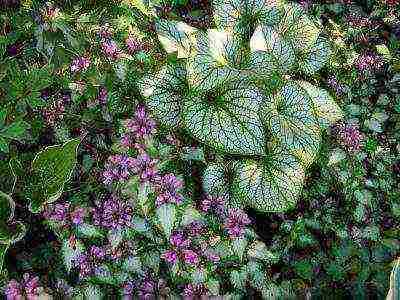
In the dry season, the lamb is attacked by such pests as spider mites, scale insects, whiteflies. Pests can be detected by their eggs in the form of small white or red-brown dots that have accumulated on leaves and stems. Sometimes the grass is, as it were, entwined with a thin web, a sticky bloom appears on the leaves and stems, and white midges are circling over the flowers. All this indicates the presence of pests.To get rid of them, the plant can be treated with soapy water, alcohol or oil, as well as special insecticidal preparations.
Reproduction technique
Speckled lamb is easy enough to breed in the garden. Since the plant in nature is a wild-growing grass, at the end of summer, the lamb begins to shed its seeds itself. But it is better to thin out the emerging sprouts so that the grass does not grow too densely. In addition, this flower is cross-pollinated, so self-seeding leads to the rapid disappearance of varietal traits. Gardeners propagate speckled speckled in the following ways:
- seeds;
- taps;
- cuttings;
- dividing the bush.
Germinating grass with seeds is easy enough. Since the plant is resistant to low temperatures, there is no need to create special greenhouse conditions for the seeds. It is enough to pour the seeds onto the surface of the soil and just push them a little deeper. Before sowing, the soil should be slightly moistened. The procedure can be started already in the middle of winter, and with the onset of the first spring heat, the seedlings can be transplanted into open ground. Seeds collected in the fall are sometimes planted in the ground before winter. However, the first flowering after planting with seeds is possible only after 2 years.
Although it is recommended to cut the bends, some of them are used as planting material. To do this, the bends are pressed to the ground and covered with earth. In order for the bends to take root, they must be constantly watered. When the sprout takes root, it is cut off from the main plant and transplanted to a new location.
Unlike other varieties, spotted lamb is easy to propagate by cuttings. To do this, cut off young stems and immediately plant them in the ground. Cuttings are planted at a distance of 10-15 cm from each other. This method is also good because cuttings can be carried out during the entire growing season.
Dividing the bush allows you to preserve the varietal characteristics of the plant. This is the most common breeding method for the lamb. The overgrown bush in the spring is carefully dug up, divided into several parts and immediately planted in the soil separately from each other. The lamb takes root quickly and does not suffer from a change in location. Gardeners even recommend replanting grass to a new site every 5 years.
And a little about secrets ...
The story of one of our readers Irina Volodina:
Especially depressing for me were the eyes, surrounded by large wrinkles plus dark circles and swelling. How to remove wrinkles and bags under the eyes completely? How to deal with swelling and redness? But nothing ages or rejuvenates a person as much as his eyes.
But how to rejuvenate them? Plastic surgery? Recognized - not less than 5 thousand dollars. Hardware procedures - photorejuvenation, gas-liquid pilling, radiolifting, laser facelift? Slightly more affordable - the course costs 1.5-2 thousand dollars. And when to find all this time? And it's still expensive. Especially now. Therefore, I chose a different way for myself ...
Read the article >>

